¶ Appendix J
URBAN OPERATIONS
| |
| Defense Science Board, October 1996 | |
Section I. INTRODUCTION
Urban operations (UO) are operations planned and conducted in an area of operations (AO) that includes one or more urban areas. An urban area is a topographical complex where man-made construction or high population density are the dominant features. The increasing world population and accelerated growth of cities means that UO in future conflicts will be very likely. The infantry brigade will be the primary headquarters around which units will be task organized to perform UO. Combat operations in urban areas usually occur when-
- The brigade's assigned objective lays within an urban area.
- The urban area is key (or decisive) in setting and or shaping the conditions for current or future operations.
- The urban area is in the path of a general advance and cannot be surrounded or bypassed.
- Political or humanitarian concerns require the control of an urban area or necessitate operations within it.
- Defending from urban areas supports a more effective overall defense or cannot be avoided.
- Occupation, seizure, and control of the urban area will deny the threat control of the urban area and the ability to impose its influence on both friendly military forces and the local civilian population; therefore, allowing friendly forces to retain the initiative and dictate the conditions for future operations.
UO are often conducted against enemy forces that may be mixed in with the civilian population. Therefore, the ROE and the use of combat power can often be more restrictive than in other conditions of combat.
J-1. FULL SPECTRUM OPERATIONS/UO CONCEPT
UO will be conducted within the operational framework of decisive, shaping, and sustainment operations (FM 3-0 [100-5]). Army units will conduct offensive, defensive, stability, and support (ODSS) operations within the operational framework shown in Figure J-1. These operations comprise the spectrum of UO that a brigade must be prepared to conduct (Figure J-2).
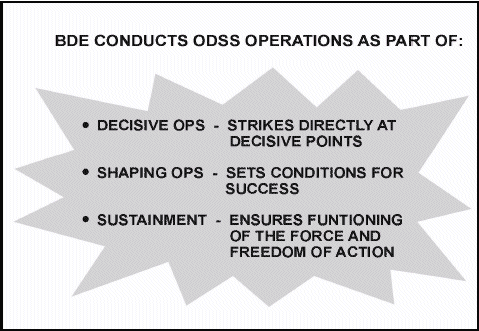
Figure J-1. Operational framework.
a. Army operational commanders assigned to conduct UO will―
- Continually assess the urban environment to determine effects on operations.
- Conduct shaping operations that emphasize isolation and set the conditions for decisive operations.
- Dominate through simultaneous and or sequential operations that establish and maintain preeminent military control over the enemy, geographical area, or population.
- Plan for and execute transitions between mission types and forces, and ultimately to the control of a non-Army agency.
b. Brigades must plan for and be prepared to conduct UO within the operational concept shown in Figure J-2, which depicts the potential simultaneity of UO. Brigades must be prepared to transition from one type of ODSS operation to another. How brigades prepare for and execute ODSS operations will be determined by the factors of METT-TC. (Within mission considerations, the ROE will have significant importance.)

Figure J-2. UO spectrum of operations/operational concept.
J-2. TACTICAL CHALLENGES
The brigade will face a number of challenges during the planning and execution of UO. The most likely challenges are discussed below.
a. Contiguous/Noncontiguous Areas of Operations. Contiguous operations are military operations that the brigade conducts in an area of operations that facilitates mutual support of combat, CS, and CSS elements. Contiguous operations have traditional linear features including identifiable, contiguous frontages and shared boundaries between forces. For brigades, contiguous operations are characterized by relatively close distances between subordinate units and elements. In noncontiguous operations, subordinate units may operate in isolated pockets, connected only through integrating effects of an effective concept of operations. Noncontiguous operations place a premium on initiative, effective information operations, decentralized security operations, and innovative logistics measures. Noncontiguous operations complicate or hinder mutual support of combat, CS, and CSS elements because of extended distances between subordinate units and elements. The brigade must be prepared to conduct ODSS operations in both types of situations. The brigade may be required to command and control subordinate battalions and elements over extended distances, which may include deploying battalions individually in support of operations in the brigade's area of influence or interest outside of the brigade's AO.
b. Symmetrical/Asymmetrical Threats. In addition to being required to face symmetrical threats, the brigade must be prepared to face threats of an asymmetrical nature. Symmetrical threats are generally "linear" in nature and include those threats that specifically confront the brigade's combat power and capabilities. Examples of symmetrical threats include conventional enemy forces conducting offensive or defensive operations against friendly forces. Asymmetrical threats are those that are specifically designed to avoid confrontation with the brigade's combat power and capabilities. These threats may use the civilian population and infrastructure to shield their capabilities from fires. Asymmetrical threats may also attack the brigade and civilian population with weapons of mass destruction (WMD). Asymmetrical threats are most likely to be based in and target urban areas to take advantage of the density of civilian population and infrastructure. Examples of asymmetrical threats include terrorist attacks; EW, to include computer-based systems; criminal activity; guerilla warfare; and environmental attacks.
c. Minimization of Collateral Damage and Noncombatant Casualties. During urban operations, brigade commanders may be required to minimize unnecessary collateral damage and noncombatant casualties. This must be balanced with mission accomplishment and the requirement to provide force protection. Brigade commanders must be aware of the ROE and be prepared to request modifications when the tactical situation requires them. Changes in ROE must be rapidly disseminated throughout the brigade. Commanders and leaders must ensure that changes to the ROE are clearly understood by all soldiers within the brigade.
d. Quick Transition from Stability or Support Operations to Combat Operations and Back. Brigade commanders must ensure that contingencies are planned to transition quickly from stability and support to combat operations and vice-versa. For example, it may be tactically wise for commanders to plan a defensive contingency with on-order offensive missions for certain stability and support operations that may deteriorate. Subordinate commanders and leaders must be fully trained to recognize activities that would initiate this transition.
Section II. MISSION, ENEMY, TERRAIN AND WEATHER, TROOPS AND TIME AVAILABLE, AND CIVIL CONSIDERATIONS (METT-TC)
Planning, preparation, and conduct of combat operations in urban areas are generally the same as any other operation. However, the commander and staff must take into account special considerations when operating in this environment.
J-3. MISSION
During operations within large cities, a brigade would probably participate as part of a division level operation. In offensive operations, the brigade may have to assist with isolating the objective, dominating (securing footholds, seizing and/or clearing buildings) an objective(s) within the city, and transitioning from combat to stability and support operations. In defensive operations, the brigade may be assigned the task to defend from a large urban area or the brigade may integrate smaller urban areas into its defensive scheme.
a. Objective. The commander and staff must clearly understand the objective of the operation. The brigade's objective may be terrain or force oriented. The commander must consider if committing his force to combat in urban areas is required or beneficial to achieving his assigned objective.
b. Intent. During planning for offensive operations, the commander and staff must consider the overall intent of the operation and define what is required to clear the urban area(s). The commander must determine if clearing means every building, block by block, or seizure of a key objective, which may only require clearing along the axis of advance. During planning for defensive operations, the commander and staff must determine if retention of urban areas within the AO is necessary to support accomplishing the mission or directed by higher headquarters. Often, the brigade can integrate urban areas into the defensive scheme to develop a stronger defense.
J-4. ENEMY
The commander and staff must consider the strength, composition, disposition, and activities of the threat. They must consider both conventional and unconventional enemy forces and the tactics they may employ. Threat tactics may range from ambushes and snipers to large-scale conventional operations conducted by heavy forces. The IPB must address the known and potential tactics of all enemy forces and threats operating within and outside the urban area and their vulnerabilities. The IPB must consider the three-dimensional environment of urban areas: airspace, supersurface, surface, and subsurface. Also, the IPB should consider the political, racial, ethnic, tribal, and religious factors that influence the threat. (See Appendix D, FM 34-130 for a detailed discussion of urban IPB.)
a. The increasing availability of sophisticated technology has created unorthodox operational approaches that can be exploited by potential opponents. These threats seek to counter the technological and numerical advantages of US joint systems and forces, and to exploit constraints placed on US forces due to cultural bias, media presence, ROE, and distance from the crisis location.
b. Offsetting their inherent weaknesses, enemy forces seek an advantage in urban terrain to remain dispersed and decentralized, adapting their tactics to provide them the best success in countering a US response. Threats, in addition to conventional forces, may consist of:
- Unconventional forces.
- Paramilitary forces.
- Militia and special police organizations.
- Organized criminal organizations.
These forces range from units equipped with small arms, mortars, machine guns, antiarmor weapons, and mines to very capable mechanized and armor forces equipped with current generation equipment. Urban environments also provide many passive dangers such as disease from unsanitary conditions and psychological illnesses. While active threats vary widely, many techniques will be common to all. Figure J-3 provides a set of tactics available to threat forces opposing mission accomplishment in urban areas.
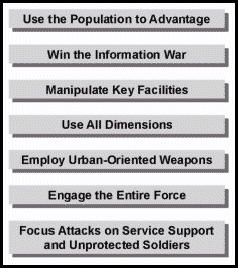
Figure J-3. Urban threat tactics.
(1) Use the Population to an Advantage. The populace of a given urban area represents key terrain; the side that manages it best has a distinct advantage. Future urban battles may see large segments of the populace remain in place as they did in Budapest and Grozny. Brigades involved in urban stability operations and support operations will certainly conduct missions in and amongst the residents of the area.
(a) Threat forces may use the population to provide camouflage, concealment, and deception for their operations. Guerilla and terrorist elements may look no different from any other member of the community. Even conventional and paramilitary troops may often have a "civilian" look. Western military forces adopted the clean-shaven, close-cut hair standard at the end of the nineteenth century to combat disease and infection, but twenty-first century opponents might very well sport beards as well as civilian clothing and other "nonmilitary" characteristics.
(b) The populace may also provide cover for threat forces, enhancing their mobility in proximity to friendly positions. Threat forces may take advantage of US moral responsibilities and attempt to make the civil population a burden on the Army's logistical and force protection resources. They may herd refugees into friendly controlled sectors, steal from US-paid local nationals, and hide among civilians during offensive operations.
(c) The civil population may also serve as an important intelligence source for the threat. Local hires serving among US soldiers, civilians with access to base camp perimeters, and refugees moving through friendly controlled sectors may be manipulated by threat forces to provide information on friendly dispositions, readiness, and intent. In addition, threat special purpose forces and hostile intelligence service assets may move among well-placed civilian groups.
(2) Win the Information War. Threat forces may try to win the information war as much as they may directly oppose the brigade's operations. Portable video cameras, Internet access, commercial radios, and cellular telephones are all tools that permit threat forces to tell their story.
(a) American "atrocities" may be staged and broadcast. Electronic mail may be transmitted to sympathetic groups to help undermine resolve. Internet websites provide easy worldwide dissemination of threat propaganda and misinformation. Hackers may gain access to US sites to manipulate information to the threat's advantage.
(b) The threat may make skillful use of the news media. Insurgent campaigns, for example, need not be tactical military successes; they need only make the opposition's campaign appear unpalatable to domestic and world support. The media coverage of the Tet Offensive of 1968 affected the will of both the American people and their political leadership. Although the battle for Hue was a tactical victory for the US, the North Vietnamese clearly achieved strategic success by searing the American consciousness with the high costs of urban warfare.
(3) Manipulate Key Facilities. Threat forces may identify and quickly seize control of critical components of the urban area to help them shape the battlespace to their advantage. Telephone exchanges provide simple and reliable communications that can be easily secured with off-the-shelf technologies. Sewage treatment plants and flood control machinery can be used to implement weapons of mass destruction (WMD) strategies or to make sections of the urban area uninhabitable. Media stations significantly improve the information operations position of the controlling force. Power generation and transmission sites provide means to control significant aspects of civilian society over a large area.
(4) Use the Three Dimensions of Urban Terrain. Upper floors and roofs provide the urban threat excellent observation points and battle positions above the maximum elevation of many weapons. Shots from upper floors strike armored vehicles in vulnerable points. Basements also provide firing points below many weapons' minimum depressions and strike at weaker armor. Sewers and subways provide covered and concealed access throughout the area of operations. The threat will think and operate throughout all dimensions of the urban environment. Conventional lateral boundaries will often not apply if friendly forces and threat forces control different floors of the same building.
(5) Employ Urban Oriented Weapons. Whether they are purpose-built or adapted, many weapons may have greater than normal utility in an urban environment while others may have significant disadvantages. Urban threat weapons are much like the nature of urbanization and the urban environment―inventive and varied. Small, man-portable weapons, along with improvised munitions, will dominate the urban environment. Figure J-4 lists examples of threat weapons favored in UO.
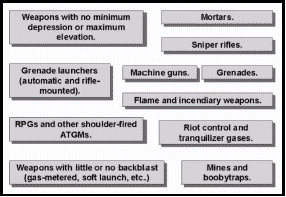
Figure J-4. Favored threat weapons.
(6) Engage the Entire Enemy Force. Threat forces may "hug" brigades operating in an urban area to avoid the effects of high-firepower standoff weapon systems. They may also try to keep all or significant portions of the brigade engaged in continuous operations to increase their susceptibility to stress-induced illnesses. UO, by their nature, produce an inordinate amount of combat stress casualties and continuous operations exacerbate this problem. The threat may maintain a large reserve to minimize the impact of this on their own forces.
(7) Focus Attacks on Service Support and Unprotected Soldiers. Threat forces may prey on soldiers poorly trained in basic infantry skills. Ambushes may focus on these soldiers while they are conducting resupply operations or moving in poorly guarded convoys. Urban operations are characterized by the isolation of small groups and navigational challenges, and the threat may use the separation this creates to inflict maximum casualties even when there is no other direct military benefit from the action.
J-5. TERRAIN AND WEATHER
An urban area is a concentration of structures, facilities, and people that form the economic and cultural focus for the surrounding area. Brigade operations are affected by all five categories of urban areas. Cities, metropolises, and megalopolises with associated urban sprawl cover hundreds of square kilometers. Brigades normally operate in these urban areas as part of a larger force. Extensive combat in these urban areas involves units of division level and above.
- Villages (population of 3,000 or less). The brigade's AO may contain many villages. Battalions and companies bypass, move through, defend from, and attack objectives within villages as a normal part of brigade operations.
- Towns and small cities (population up to 100,000 and not part of a major urban complex). Operations in such areas normally involve brigades or divisions. Brigades may bypass, move through, defend in, or attack enemy forces in towns and small cities as part of division operations.
- City (population over 100,000 to 1 million inhabitants).
- Metropolis (population over 1 million to 10 million inhabitants).
- Megalopolis (population over 10 million inhabitants).
a. Terrain. A detailed analysis of the urban area and surrounding terrain is vital to the success of any operation in an urban area. (See Appendix D, FM 34-130.) The brigade commander must understand the elements of the urban infrastructure that are necessary for achieving the intent and end-state of the brigade's mission. Military maps normally do not provide sufficient detail for terrain analysis of an urban area. Recent aerial photographs and other current intelligence products are critical. Maps and diagrams of the city from other sources, such as those from local governments, tourist activities, or law enforcement services, can be useful. Products that can be developed by the National Imagery Mapping Agency (NIMA) can be specifically tailored for the brigade area of operations. Also, the S2 should obtain blueprints, maps, or diagrams of the following:
- Subway systems, railways, and mass transit routes.
- Underground water, sewer, and utility systems.
- Electrical power stations and emergency services.
- Fuel supply and storage facilities.
- Mass communications facilities such as cellular phones, computer hubs, radio, and telephone.
- Public administration buildings, hospitals, and clinics.
(1) The terrain analysis should also identify the following:
- Structural characteristics of buildings, bridges, and transportation networks.
- Roads/highways, rivers/streams, or other waterways that may be used as high speed avenues of approach.
- Analysis of the natural terrain surrounding the urban area (OAKOC).
- Analysis of urban area itself to include street pattern, type structures and available maneuver space. (See FMs 34-130 and 90-10-1.)
- Covered and concealed approaches to the urban area.
- Key and decisive terrain inside and outside of the urban area.
- Identification of buildings, areas, or facilities protected by the law of land warfare and or restricted by current ROE such as churches, hospitals, historic monuments, and other facilities dedicated to arts and sciences, provided they are not being used for military purposes. (See FM 27-10.)
- Areas and facilities restricted by current ROE, such as religious buildings, hospitals, and so forth.
- Stadiums, parks, open fields, playgrounds, and other open areas that may be used for landing zones or holding areas.
- Location of prisons and jails.
- Potential host nation support facilities such as quarries, lumber yards/major building supply companies, and warehouses.
- Power lines, telephone lines, and raised cables that may be hazards to helicopters.
- Significant fire hazards and locations of other toxic industrial materials (TIM).
- Weather effect products from topographic models or historical sources; for example, effects of heavy rains on local areas.
Note: Recent incidental or intentional destruction of structures or new construction can change the topography of an urban area.
(2) A close relationship with the local government and military forces can be very beneficial. They can provide information about the population, fire fighting capabilities, locations of hazardous materials, police and security capabilities, civil evacuation plans, location of key facilities, and possibly current enemy activities. They may also be able to provide translators.
(3) A logistics infrastructure analysis of the urban area is also important. Because urban infrastructures vary greatly, a comprehensive list cannot be provided. However, common characteristics include:
- Urban street patterns and trafficability.
- Sources of potable water.
- Bulk fuel and transport systems.
- Canals and waterways.
- Communications systems.
- Rail networks, airfields, canals and waterways, and other transportation systems.
- Industries.
- Power (to include nuclear) and chemical production facilities and public utilities.
b. Weather. Weather analyses include visibility, winds, precipitation, and temperature and humidity.
(1) Visibility. Light data have special significance during urban operations. Night and periods of reduced visibility, to include periods of fog, favor surprise, infiltration, detailed reconnaissance, attacks across open areas, seizure of defended strong points, and reduction of defended obstacles. However, the difficulties of night navigation in restrictive terrain, without reference points and near the threat, forces reliance on simple maneuver plans with easily recognizable objectives. Many major cities are located along canals or rivers, which often create a potential for fog in low-lying areas. Industrial and transportation areas are the most affected by fog due to their proximity to waterways. In heavy industrial areas, smog can also limit observation under all light conditions.
(2) Winds. Wind chill is not as pronounced in urban areas. However, the configuration of streets, especially in close-orderly block and high-rise areas, can cause wind canalization. This increases the effects of the wind on streets that parallel the wind direction, while cross-streets remain relatively well protected. Because of these factors, swirling winds occur and the wind speed and direction may constantly change. This factor also affects the use of smoke for both friendly and threat forces. Downwind predictions for NBC and toxic industrial materials (TIM) will also be difficult.
(3) Precipitation. Rain or melting snow often floods basements and subsurface areas, such as subways. This is especially true when automatic pumping facilities that normally handle rising water levels are deprived of power. Rain also makes storm and other sewer systems hazardous or impassable. Chemical agents and other TIM are washed into underground systems by precipitation. As a result, these systems may contain toxic concentrations much higher than surface areas and become contaminated "hot spots." These effects become more pronounced as chemical agents or TIM are absorbed by brick or unsealed concrete sewer walls.
(4) Temperature and Humidity. Air inversion layers are common over cities, especially cities located in low-lying "bowls" or in river valleys. Inversion layers trap dust, chemical agents, and other pollutants, reducing visibility, and often creating a greenhouse effect, which causes a rise in ground and air temperature. The heating of buildings during the winter and the reflection and absorption of summer heat make urban areas warmer than surrounding open areas during both summer and winter. This difference can be as great as 10 to 20 degrees, and can add to the already high logistics requirements of urban combat. Summer heat, combined with the very physical requirements of urban combat, can cause severe heat-related injuries. Changes in temperature as a result of air inversions can also affect thermal sights during crossover periods of warm to cold and vice-versa. This period needs to identified as it may differ from urban area to urban area.
J-6. TROOPS
During UO, the brigade is often augmented with additional assets, which may include aviation, engineers, signal, smoke and or decontamination, ADA, MI, counterintelligence, MP, public affairs, PSYOP, civil affairs, translators, and LRS assets, when available. The brigade may also receive additional mechanized infantry or armor. A sample infantry brigade task organization is shown at Figure J-5. Actual task organizations are METT-TC dependent. How the brigade commander task organizes so that the BOS can be synchronized is of critical importance to tactical success. (See Appendix E for light/mechanized/special operations considerations.)
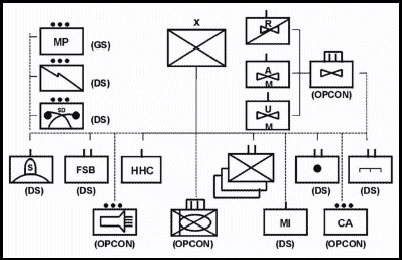
Figure J-5. Sample UO task organization for an infantry brigade.
Note: The task organization shown in Figure J-5 would be essentially the same for light, airborne, and air assault infantry brigades.
a. Troop Density, Ammunition, and Equipment. Troop density for offensive missions in urban areas can be as much as three to five times greater than for similar missions in open terrain. Troops require additional equipment such as ladders, ropes, grappling hooks, and other entry equipment. The ammunition consumption rates for small arms, grenades (all types), Claymore mines, handheld recoillesss weapons (light antitank weapons [LAWs] and AT4s), 25-mm and 120-mm HE, and explosives can be four times the normal rate. The staff must ensure the continuous supply of Classes I, III, V, and VIII supplies and water to forward units. Supplies should be configured for use and delivered as far forward as possible to supported units.
b. Stress. The commander and staff must consider the effects of prolonged combat on soldiers. Continuous close combat produces high psychological stress and physical fatigue. Rotating units that have been committed to combat for long periods can reduce stress. This may require the brigade to maintain a large reserve to assume the mission of committed forces, or the brigade may need to employ units in a follow and support role to reduce the strain on lead units. Extra effort and time should be taken to train and psychologically prepare soldiers for this type of combat. Ensuring that the proper support systems are in place and functional also reduces potential causes of stress (for example, medical/psychological, resupply, and so forth).
J-7. TIME
Combat in urban areas has a slower tempo and an increased use of methodical, synchronized missions. Additionally, the brigade may find itself planning different operations simultaneously. For example, a task force may have the mission to conduct offensive missions in one part of the brigade's AO and another battalion may be conducting stability missions in yet another part of the brigade's AO. In planning UO, the commander and staff must take these factors into account. Plans must also take into account that troops will tire more quickly because of stress and additional physical exertion caused by the environment. More time must be allowed for thorough reconnaissance and subordinate unit rehearsals. Mission-specific in-country training may be required to orient soldiers on how to deal with civilians and provide them cultural awareness. Other key skills include sniper/countersniper operations, demolitions, breaching, fire fighting, entry and movement techniques, fighting position construction, booby trap recognition/neutralization skills, combat lifesaver training, and crowd control.
J-8. CIVIL CONSIDERATIONS
The commander and staff must understand the composition, activities, and attitudes of the civilian population, to include the political infrastructure, within the urban area. Various options are available to the commander to control the impact of civilians on the operation such as screening civilians, prohibiting unauthorized movement, diverting or controlling refugee movements, and evacuating. Understanding the urban society requires comprehension of:
- Living conditions.
- Cultural distinctions.
- Ethnicity.
- Factions.
- Religious beliefs.
- Political affiliation and grievances.
- Attitude toward US forces (friendly, hostile, neutral).
a. Curfew and Evacuation. A commander with the mission of defending an urban area may need to establish a curfew to maintain security or to aid in control of military traffic. (Curfews are not imposed as punishment. They are normally established to reduce noncombatant casualties and provide a measure of force protection.) A commander can require civilians to evacuate towns or buildings if the purpose of the evacuation is to use the town or building for imperative military purposes, to enhance security, or to safeguard those civilians being evacuated. If the commander takes this action, he must specify and safeguard the evacuation routes. Food, clothing, medical, and sanitary facilities should be provided or available at the destination until the evacuees can care for themselves. Evacuated civilians must be transferred back to their homes as soon as hostilities in the area have ceased. The staff must plan for and coordinate the movement and evacuation of civilians to ensure their actions do not interfere with the military operation. The S5, brigade JAG, S3, S2, and supporting civil affairs units working with local officials coordinate the movements of civilians.
b. Resistance Groups. The brigade may encounter civilian resistance groups whose actions may range from lending supplies, services, and noncombat support to the enemy to actively fighting against friendly forces. Members of such resistance groups should be dealt with in accordance with applicable provisions of the law of war. Commanders should seek guidance from the JAG concerning the detention and disposition of persons participating in acts harmful to friendly forces. The S2, brigade JAG, PSYOP, MP, and civil affairs units must work together to identify these threats and recommend, within the ROE, the appropriate preemptive action or response, when required. The activities of resistance groups may also benefit friendly forces. They may provide HUMINT; act as guides, liaisons or translators; and provide subject matter expertise on local public facilities such as refineries, power plants, and water works. They may also provide active resistance against the threat.
Section III. COMMAND AND CONTROL
Urban operations will require centralized planning and decentralized execution. Therefore the staff must develop a detailed plan that synchronizes the BOS in order to meet the commander's intent and also provide subordinate units with the means to accomplish the mission.
J-9. FOCUS ON THE THREAT
During the mission analysis, the plan should focus on the factors of METT-TC. Make the plan enemy-oriented instead of terrain-oriented. Use terrain factors to defeat the threat. Considerations include, but are not limited to, the following:
- Thorough evaluation of the urban area's related terrain and threat may take much longer than other environments. This time factor will also impact friendly planning efforts.
- Determine the threat's location, strength, and capabilities. Develop a plan that defeats his direct and indirect fire systems.
- Focus the axis of advance on the threat's weaknesses while maintaining adequate force protection measures. When possible employ multiple and supporting axes of advance.
- Divide the objective area into manageable smaller areas that facilitate battalion TF maneuver.
- Isolate the objective area and establish a foothold at the point of entry. The location chosen for the foothold must allow for expansion.
- The brigade and battalion maneuver plans directly affect the company schemes of maneuver. Every company within the brigade must know what enemy targets will be engaged by brigade and battalion assets.
J-10. COMMANDER'S CRITICAL INFORMATION REQUIREMENTS (CCIR)
This is information required by the commander that directly affects his decisions and dictates the successful execution of tactical operations. The brigade staff must develop the components of CCIR that facilitate the commander's ability to make decisions that impact the plan during urban operations. Logical deductions are that essential elements of friendly information (EEFI) should address the enemy commander's priority intelligence requirements (PIR) and friendly forces information requirements (FFIR) should be items that cause the commander to make decisions that impact the plan. The following are examples of PIR, EEFI, and FFIR that would be more likely to help the commander in an urban environment.
a. PIR. These are intelligence requirements that a commander has anticipated and have stated priority in task planning and decision making. Examples include:
- Where are the threat battalion and company command posts?
- What are the most likely threat infiltration routes into the brigade area of operations?
- What streets and alleys restrict movement of friendly armored and wheeled vehicles?
- Where are the likely threat strong points and engagement areas?
- What is the threat air defense capability against Army aviation assets?
b. EEFI. These are critical aspects of a friendly operation that, if known by the threat, would subsequently compromise, lead to failure, or limit success of the operation and, therefore, must be protected from detection. Examples include:
- Is the brigade command net vulnerable to intercept, direction finding, and electronic attack?
- Is the brigade vulnerable to HUMINT collection and sabotage by local nationals?
- Where are the brigade supply routes/LOC most vulnerable to ambush and snipers?
- Are friendly troop concentrations and movement under threat observation?
c. FFIR. This is information the commander and staff need about the friendly forces available for the operation. Examples include:
- Scouts captured or compromised.
- Main bridge locations along ground route that have been blown.
- OPORD compromised.
- Loss of cryptographic equipment.
- Expected personnel and equipment replacements that did not arrive.
J-11. TASK-ORGANIZE UNITS TO ACCOMPLISH SPECIFIC TASKS
Urban operations may require unique task organizations. Figure J-6 depicts a sample brigade task organization for offensive operations, showing units under brigade control, and subordinate task forces necessary to accomplish decisive and shaping operations, specifically, the main and supporting efforts and the brigade reserve. Commanders must consider providing assets where they will be needed to accomplish specific tasks. All phases of mission execution must be considered when developing task organization. Changes in task organization may be required to accomplish different tasks during mission execution. Task organizations could very well change from shape through transition.
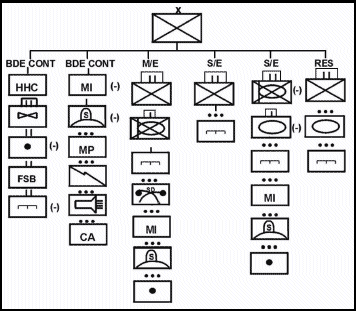
Figure J-6. Sample brigade task organization for offensive UO.
Note: Figure J-6 also depicts two field artillery platoons that have been given DS missions to provide direct fire support to the main and the supporting attacks.
J-12. REHEARSALS
After developing a thorough, well-synchronized plan, brigade commanders should require subordinate units to conduct combined arms rehearsals and include all phases of the operation. When conducted properly, combined arms rehearsals identify potential problems in the synchronization of the plan between maneuver, combat support, and combat service support elements. Rehearsals provide a means for units that seldom operate together to train collective skills. Carefully consider where rehearsals will be conducted within the brigade AO. It is preferable to conduct rehearsals on urban terrain similar to the objective area.
J-13. FIRE SUPPORT
Often, the role of fires in UO is to get the maneuver force into or around the urban area with minimal casualties, so the commander has the maximum combat power to close with the enemy and finish the fight. The fire support officer can use the acronym SOSR (suppress, obscure, secure, reduce) as a reference to assist the commander in developing his intent for fires. History has shown that short, violent preparatory fires are much more effective than fires of long duration. Fires of shorter duration also produce less rubble and collateral damage. If available, the smoke decontamination platoon should be considered as a fire support asset for obscuration. Nonlethal capabilities are also planned and coordinated by the fire support officer for the brigade commander. Civil affairs and PSYOP assets should be coordinated with the appropriate command and control warfare/information operations planning headquarters.
Section IV. OFFENSIVE OPERATIONS
| |
|
Technical Memorandum 5-87 Modern Experience in City Combat U.S. Army Human Engineering Laboratory March, 1987 | |
The brigade may be assigned an objective that lies within an urban area. The brigade may conduct the full range of offensive operations within a single large city or in an AO that contains several small towns and cities. Given the nature of urban terrain, an attack in an area is similar to the techniques employed in attacking a strongpoint. Attacking the enemy's main strength is avoided and combat power is massed on the weakest portion of his defense.
J-14. OFFENSIVE FRAMEWORK
Figure J-7 depicts the operational framework of brigade urban offensive operations. The brigade commander's primary responsibility is to set the conditions for tactical success for his subordinate units. Whenever possible, close combat by maneuver units is minimized and brigades attempt to move from assess to transition. The tactical tasks of subordinate units during offensive operations are also shown in Figure J-5. The elements of offensive operations are not phases. There is no clear line of distinction that delineates when the brigade moves from one element to another. Properly planned and executed actions will involve all four elements. They may be conducted simultaneously or sequentially, depending on the factors of METT-TC. During offensive operations, the brigade commander seeks to―
- Synchronize precision fires (lethal and non-lethal effects) and information operations.
- Isolate decisive points.
- Use superior combat power to destroy high pay-off targets.
- Use close combat, when necessary, against decisive points.
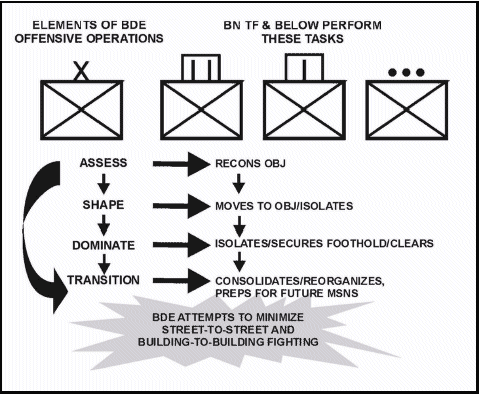
Figure J-7. Offensive urban operational framework.
J-15. ASSESS
Brigades primarily assess the urban environment using the military decision-making process (MDMP); intelligence preparation of the battlefield (IPB) acts as a key tool in that process. IPB is combined with the following:
- Division or joint task force (JTF) reconnaissance efforts and other shaping operations.
- Reconnaissance efforts of brigade units.
- Results of previous operations that impact current operations.
a. An important step in mission analysis is to determine the essential tasks. Combat power is applied precisely at decisive points, and other portions of the urban area are isolated to the extent necessary to ensure they do not adversely influence the UO. Operations will be conducted both sequentially and simultaneously, as appropriate. Specific tasks to subordinates may address the full spectrum of Army operations, and the command will likely be conducting support, stability, and combat operations simultaneously. The complexity of UO may require simultaneous full spectrum operations down to company level.
b. The brigade commander and staff must determine, during assessment, whether the shaping efforts of higher headquarters are sufficient for the brigade to accomplish its mission(s) or whether additional shaping efforts are required-for example, isolation of nodes or other key terrain. Additionally, the brigade commander and staff must assess whether the shaping efforts of higher headquarters permit them to move directly to domination and or transition.
J-16. SHAPE
Brigades normally shape the area of operations through isolation. Isolation is defined as a tactical task to seal off (both physically and psychologically) an enemy from his sources of support, to deny an enemy freedom of movement, and prevent an enemy unit from having contact with other enemy forces. During isolation, the brigade commander sets the conditions for tactical success. Implied in this step are the thorough reconnaissance of the objective(s) and movement of subordinate units to positions of tactical advantage. The brigade commander must carefully determine the extent and the manner in which his forces can isolate the objective(s). The factors of METT-TC will determine how the brigade will isolate the objective psychologically and physically. Only areas essential to mission success are isolated.
a. Psychological Isolation of the Objective. Isolation begins with the efforts of the division and corps psychological and civil affairs operations to influence enemy and civilian actions. The brigade commander should consider using PSYOP teams to broadcast appropriate messages to the threat and to deliver leaflets directing the civilian population to move to a designated safe area. These actions must be coordinated with the overall PSYOP plan for the theater and must not sacrifice surprise. By themselves, PSYOP are seldom decisive. They take time to become effective and often their effects are difficult to measure until after the actual attack, but they have usually proven to be successful. Under some METT-TC conditions, they have achieved results far outweighing the effort put into them.
b. Sensors and Reconnaissance Units. One of the more common methods of isolation involves the use of a combination of sensors and reconnaissance units along avenues of approach to detect enemy forces as they attempt to enter or leave the objective area. The brigade can engage these enemy forces with indirect fires, aerial fires, or a combination of the two, consistent with the ROE. This technique may be effective in detecting and stopping large enemy units from entering or leaving, but the cover and concealment the urban area provides will make it very difficult to totally seal off the urban objective. To be successful, this technique requires skillful reconnaissance units and responsive fires. It may not be possible for the brigade to observe all avenues of approach, and enemy units may escape detection by infiltrating or exfiltrating. It may be difficult to distinguish between enemy and friendly personnel and noncombatants moving in and out of the urban area. Indirect fires may cause unacceptable damage to key parts of the urban area.
c. Snipers. In certain situations that require precise fire, snipers can provide an excellent method of assisting in isolating key areas. Skillful application of snipers can provide lethal fire while simultaneously minimizing collateral damage and noncombatant casualties. Snipers can also be used to observe and report enemy activity and to call for and adjust indirect fire.
d. Combination of Assets. The most effective method of isolating an urban objective(s) will probably be the use of a combination of sensors, reconnaissance elements, and maneuver forces. The brigade can move platoons and companies into positions where they can dominate avenues of approach with observation and direct fires. Smaller urban areas with clearly defined boundaries will make this method easier to accomplish. Larger urban areas may prevent a maneuver force from gaining access to a position from which to stop enemy movement into the objective area.
e. Use of Fires and Smoke. In some instances, where the ROE permit, indirect and aerial fires may be the only available or appropriate method of isolation. This is the most destructive technique; it demands large amounts of ammunition, and it may only last for short periods of time. Brigade fire planners can improve the effectiveness of this technique by careful selection of high pay-off targets and use of precision munitions. Mortar and light artillery fires falling onto large buildings are not as effective in preventing enemy movement as fires falling into open areas. Targeting them against larger avenues, parks, and other open areas will force the enemy to move within buildings. Artillery and aerial fires can be directed against buildings that the enemy is using for movement and observation. This will slow and impede enemy movement, but not stop it. It can also hinder enemy supply efforts and make it difficult to reinforce units under attack. Targeting obvious choke points, such as bridges or main road junctions, can also assist in the isolation effort. Smoke can be used to isolate the objective(s) from enemy observation, but it is difficult to predict what smoke will do in an urban area.
Note: Multiple flat polished surfaces in an urban area may degrade laser use, thereby rendering some weapon systems useless. Close coordination must occur between maneuver and fire support planners in order to obtain the desired effects of laser-guided precision munitions. Also, obscuration rounds may cause uncontrolled fires in the city and must be carefully planned.
J-17. DOMINATE
The brigade will use all combined arms available, consistent with the ROE, to defeat or destroy the enemy at decisive points and achieve the desired end-state of the mission. The brigade seeks to dominate the enemy through well-planned isolation and skillful use of combined arms. The brigade commander seeks to minimize the amount of street to street and house to house fighting that must be performed by battalions.
J-18. TYPES OF OFFENSIVE OPERATIONS
The brigade will conduct the same types of offensive operations as it would on open terrain. (See Chapter 5, Sections II, III, and IV.) Techniques that may be more applicable during urban offensive operations are discussed in the following paragraphs. These techniques are applicable to all forms of offensive maneuver and would be determined by METT-TC factors.
a. Movement to Contact, Search and Attack Technique. Figure J-8 depicts a brigade conducting a movement to contact in an urban area using the search and attack technique. This technique is used when knowledge of the enemy is unclear and contact is required. It is normally employed against a weak enemy force that is disorganized and incapable of massing strength against task forces (for example, urban insurgents or gangs). The brigade divides the AO into smaller areas and coordinates the movement of battalions through the brigade AO. In the example shown at Figure J-6, the enemy is found and fixed during isolation and finished during domination. During a mission of this type, the urban environment makes it difficult for conventional infantry forces to find, fix, and finish the enemy. For example, movement of units may become canalized due to streets and urban "canyons" created by tall buildings. The application of fire power may become highly restricted based on the ROE. The use of HUMINT in this type of action becomes increasingly more important and can be of great assistance during the "find" portion of the mission. (Table J-1 shows the advantages and disadvantages of search and attack.)
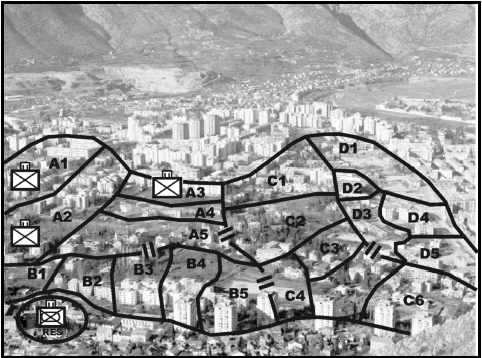
Figure J-8. Search and attack technique.
|
TECHNIQUE |
ADVANTAGES |
DISADVANTAGES |
|
Search and Attack |
Requires enemy to fight in multiple directions. Increases maneuver space and flexibility. |
Difficult to command and control. Difficult to provide CS and CSS. Difficult to provide for mutual support of maneuver forces. Find/fix/finish forces are challenged/limited. |
Table J-1. Advantages and disadvantages of search and attack.
b. Attack on a Single Axis. If the brigade must mass combat power in order to conduct a deliberate attack against an enemy strongpoint, an attack on a single axis may be considered. This technique would be used when the axis of advance is not well defended by the enemy. Figure J-9 depicts a brigade conducting an attack on a single axis on OBJ GOLD. In the example shown, the lead task force(TF) has the mission of conducting a supporting attack to seize OBJ 22 and facilitate passage of the second the TF through OBJ 22. The second TF conducts the main attack to seize and clear OBJ 21 with an on order mission to seize OBJ 23. A third TF follows in reserve. In the example shown below, the brigade would normally receive assistance in isolating the objective. (Table J-2 shows the advantages and disadvantages of an attack on a single axis.)
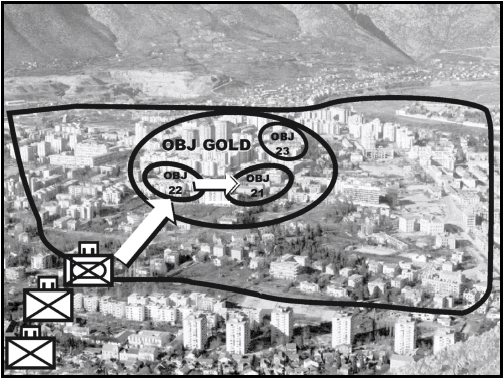
Figure J-9. Attack on a single axis.
|
TECHNIQUE |
ADVANTAGES |
DISADVANTAGES |
|
Attack on a Single Axis |
Facilitates command and control. Limited combat power to the front. Concentrates combat power at a critical point. |
Limits manuever. Presents denser target to the enemy. Presents a single threat to the enemy. Reduces flexibility. |
Table J-2. Advantages and disadvantages of an attack on a single axis.
c. Attack on Multiple Axes. If enemy defenses are more robust and the brigade commander wishes to force the enemy to fight in multiple directions, an attack on multiple axes can be considered. Figure J-10 depicts a brigade conducting the same attack on OBJ GOLD using multiple axes. In this case a battalion task force (air assault) conducts an air assault on OBJ C and then conducts a supporting attack to seize OBJ D. A second task force conducts a supporting attack to seize OBJ B, with a third conducting the main attack to seize and clear OBJ A. The supporting attacks isolate OBJ A. (Table J-3 shows the advantages and disadvantages of an attack on multiple axes.) Synchronization of BOS is crucial to ensure the massing of effects at the critical points and to prevent the isolation and piecemeal destruction of smaller elements separated by the structures in the urban area.
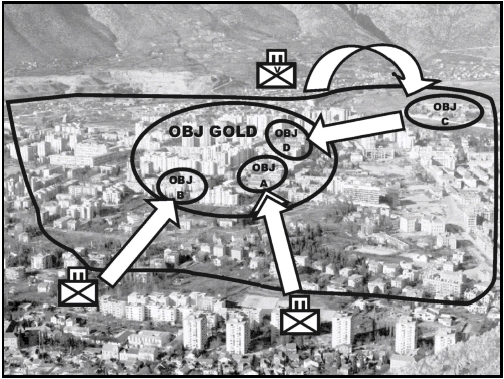
Figure J-10. Attack on multiple axes.
|
TECHNIQUE |
ADVANTAGES |
DISADVANTAGES |
|
Attack on Multiple Axes |
Better distributes combat power. Requires the enemy to fight in multiple directions. Increases maneuver space and flexibility. |
More difficult to command and control. More difficult to provide CS and CSS. |
Table J-3. Advantages and disadvantages of an attack on multiple axes.
Figure J-11 depicts an attack on multiple axes on different terrain. In this situation the brigade has the mission to seize OBJ ZULU (OBJs DOG, RAT, and CAT). The brigade commander has decided to attack on multiple axes with two battalion task forces conducting supporting attacks to seize OBJs DOG and RAT in order to isolate OBJ CAT. The brigade main attack will seize and clear OBJ CAT.
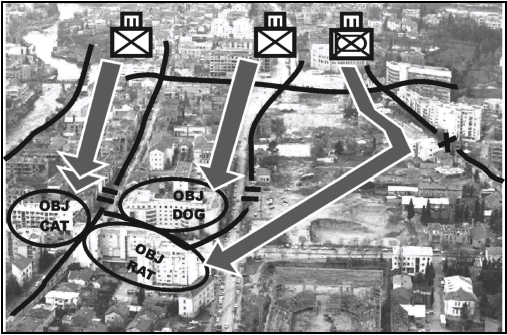
Figure J-11. Attack on multiple axes, different terrain.
d. Cordon and Attack. The brigade may find itself in a position where it may physically isolate a large portion of an urban objective. The brigade commander may also determine that he can force the enemy out of his position(s) and out into more open areas where he can be engaged by direct and indirect fires. In this case, the cordon and attack technique may be considered. A cordon is a type of isolation. Cordon is a tactical task given to a unit to prevent withdrawal from or reinforcement of a position. Cordon implies seizing or controlling key terrain and or mounted and dismounted avenues of approach. Figure J-12 depicts a brigade attacking to seize and clear OBJ EAGLE using the cordon and attack technique. One task force (four company teams) cordons OBJ EAGLE by occupying battle positions. (A cordon may also be accomplished using ambushes, roadblocks, checkpoints, OPs, and patrols.) The example in Figure J-12 shows one TF seizing and clearing OBJ EAGLE and another as the brigade reserve. Skillful application of fires and other combat multipliers may also defeat the enemy when this technique is used and minimize or preclude close combat. (Table J-4 lists the advantages and disadvantages of cordon and attack.
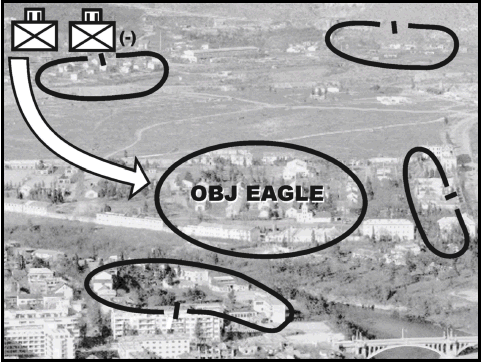
Figure J-12. Cordon and attack.
Note: In the example shown in Figure J-12, the battle positions are oriented to place fires on the enemy leaving OBJ EAGLE and to prevent his withdrawal from the objective area. The factors of METT-TC will determine how the battle positions are oriented and what the mission end-state will be. Additional direct fire control measures, such as TRPs and engagement areas, as well as indirect fire control measures can focus fires and assist in canalizing the enemy into desired areas.
|
TECHNIQUE |
ADVANTAGES |
DISADVANTAGES |
|
Cordon and Attack |
Concentrates combat power. Provides mutual support of maneuver forces. |
Sequencing the cordon can be difficult. Considerable combat power can be committed to the cordon. |
Table J-4. Advantages and disadvantages of cordon and attack.
e. Fix and Bypass. A brigade may find itself in a position where it is conducting operations near an urban area that needs to be bypassed. In certain situations the enemy may have to be fixed prior to the brigade's bypassing the urban area. Figure J-13 depicts a brigade conducting a limited offensive action to fix the enemy with a small force and bypass the urban area with the bulk of the brigade's combat power. If entering the urban area is unavoidable or force protection requirements force the brigade to attack the urban area, the fix and bypass technique may be considered. (Table J-5 lists the advantages and disadvantages of fix and bypass.) It is preferable to completely avoid the urban area if it will eventually be bypassed. During the planning process, routes should be chosen so that close combat in the urban area can be avoided. Also, the brigade may be able to fix the enemy with fires and avoid having to enter the urban area.
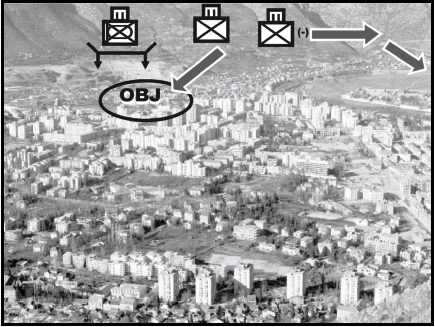
Figure J-13. Fix and bypass.
|
TECHNIQUE |
ADVANTAGES |
DISADVANTAGES |
|
Fix and Bypass |
Avoids urban area. Facilitates freedom of action. |
Requires the brigade to separate, commit, and support part of its force. Fixing force may become isolated and cut off. |
Table J-5. Advantages and disadvantages of fix and bypass.
f. Multiple Nodal Attacks. The brigade may be given the mission to attack multiple nodes either simultaneously or sequentially. This mission is characterized by rapid attacks followed by defensive operations. The enemy situation must permit the brigade to divide its forces and seize key nodes. Multiple attacks such as this will require precise maneuver and supporting fires. This mission may be given to a brigade before an anticipated stability operation, or to isolate an urban area for other units that will be conducting offensive operations inside the urban area. Figure J-14 depicts a brigade conducting multiple nodal attacks. This technique is used to deny the enemy the use of key infrastructure. Use of this technique may also require a designated rapid response element(s) in reserve in the event that enemy forces mass and quickly overwhelm an attacking battalion. The duration of this attack should not exceed the brigade's self-sustainment capability. (Table J-6 lists the advantages and disadvantages of multiple nodal attacks.)
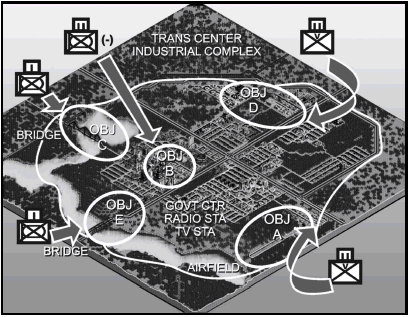
Figure J-14. Multiple nodal attacks.
|
TECHNIQUE |
ADVANTAGES |
DISADVANTAGES |
|
Multiple Nodal Attacks |
Presents multiple threats to the enemy. Increases maneuver space and flexibility. |
Difficult to command and control. Difficult to provide CS and CSS. Difficult to provide for mutual support of maneuver forces. Difficult to sequence. |
Table J-6. Advantages and disadvantages of multiple nodal attacks.
J-19. TRANSITION
During transition, the brigade continues to use all CS and CSS assets consistent with the mission end-state and ROE to move from combat operations to stability and/or support operations in order to return the urban area back to civilian control. During this step the roles and use of SOF and CSS units, such as civil affairs (CA), PSYOP, medical, and MPs become more important with the requirements to maintain order and stabilize the urban area. Subordinate task forces and other brigade units will be consolidating, reorganizing, conducting area protection and logistical missions, and preparing for follow-on missions. The brigade staff must prepare to transition from being a "supported" force to being the "supporting" force. (See paragraph Section VI, Stability and Support Operations.)
Section V. DEFENSIVE OPERATIONS
Of the two types of defense, area and mobile, the area defense will probably be the type most used since most of the reasons for defending an urban area are focused on retaining terrain. The mobile defense pattern is more focused on the enemy and the commander may decide to use it based on his estimate of the situation. In a urban area, the defender must take advantage of the abundant cover and concealment. He must also consider restrictions to the attacker's ability to maneuver and observe. By using the terrain and fighting from well-prepared and mutually supporting positions, a defending force can inflict heavy losses upon, delay, block, or fix a much larger attacking force. A commander must decide whether defending an urban area is needed to successfully complete his mission. Before making his decision, the commander should consider the issues discussed in this paragraph.
J-20. DEFENSIVE FRAMEWORK
The brigade can conduct the full range of defensive operations within a single urban area or in an AO that contains several small towns and cities using the elements shown in the defensive urban operational framework in Figure J-15. The elements are similar to those in offensive operations in that the brigade commander attempts to set the conditions for tactical success. Isolation of the brigade by the enemy is avoided through security operations; defensive missions are assigned subordinate task forces in order to achieve the commander's intent and desired end-state; and then the brigade transitions to stability and or support operations. During urban defensive operations, the transition to stability and support operations may not be clear to the soldiers conducting the operations. Commanders must offset this tendency with clear mission type orders and updated ROE. Again, as in offensive operations, the elements are not phases. They may occur simultaneously or sequentially. Well planned and executed defensive operations will have all three elements present. During defensive operations the brigade commander seeks to―
- Avoid being isolated by the enemy.
- Defend only the decisive terrain, institutions, or infrastructure.
- Conduct counter or spoiling attacks to retain the initiative.
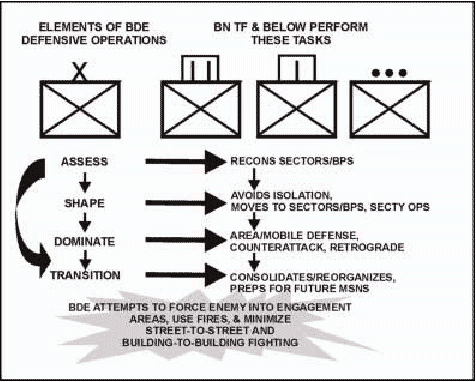
Figure J-15. Defensive urban operational framework.
J-21. INTEGRATING THE URBAN AREA INTO THE DEFENSE
The brigade may also integrate villages, strip areas, and small towns into the overall defense, based on higher headquarters' constraints and applicable ROE (Figure J-16.) A defense in an urban area or one that incorporates urban areas normally follows the same sequence of actions and is governed by the principles contained in Chapter 5, Defensive Operations and Chapter 6, Retrograde Operations. When defending large urban areas, the commander must consider that the terrain is more restrictive due to buildings that are normally close together. This requires a higher density of troops and smaller AOs than in open terrain. The brigade normally assigns task force AOs and may use phase lines, control measures, or other positions to position forces in depth.
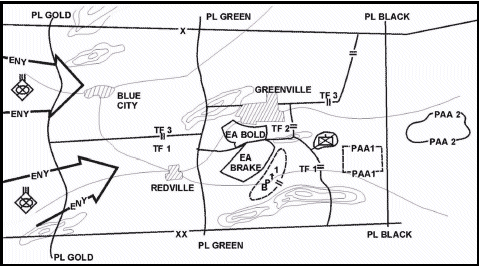
Figure J-16. Integrating urban areas into a defense.
J-22. NODAL DEFENSE
Figure J-17 depicts a transitional situation where the brigade moves from an offensive to a defensive or stability operation. The brigade mission may contain METT-TC factors that require varying defensive techniques by the subordinate battalion TFs under the brigade's control. Considerations in a situation such as this include:
a. Task Organization. TFs may very well have to be task organized differently to conduct the specific missions assigned by the brigade commander. The task organization required for the defensive or stability operation will probably be different from the task organization used in an offensive operation.
b. Symmetrical/Asymmetrical Threats. The brigade will likely respond to both symmetrical and asymmetrical threats within the area of operations. The defensive techniques chosen by subordinate battalion TFs should be capable of responding to the specific threats in their respective AOs.
c. Boundary Changes. Again, based on the commander's intent and the brigade's defensive scheme of maneuver, boundary changes may be required in order to give battalion's more or less maneuver space.
d. ROE Modification. The ROE may require modification based on the type of mission to be conducted. The ROE may become more or less restrictive based on METT-TC factors. Commanders and leaders must insure that the ROE are clearly stated and widely disseminated at the beginning and conclusion of each day.
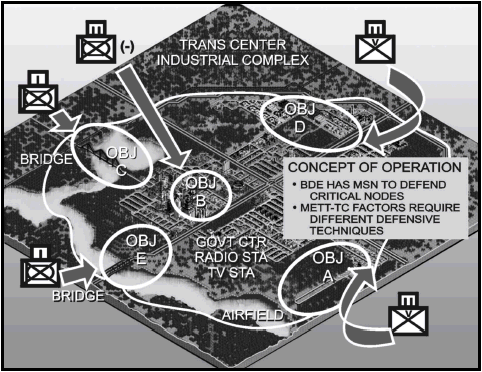
Figure J-17. Nodal defense, transitional situation.
Figure J-18 depicts a nodal defense where TFs employ varying defensive techniques in order to achieve the brigade commander's desired end-state. The brigade commander's intent is to safeguard the key nodes that were seized during the offensive action in order to eventually return the infrastructure of this particular urban area back to civilian control. A combination of sectors, battle positions, strong points, road-blocks, checkpoints, security patrols, and OPs could be employed throughout the brigade AO. Figure J-18 depicts the changed TF task organizations, the extended boundaries, and directed brigade OPs.
Note: TF operational graphics were drawn in order to provide an example of a possible technique that may be employed within the brigade AO in order to meet the brigade commander's intent. For example, the TF defending the transportation center has elected to use a perimeter defense for inner security and has assigned the attached mechanized infantry company team the mission to conduct outer security by means of a screen and manning the designated brigade OP.
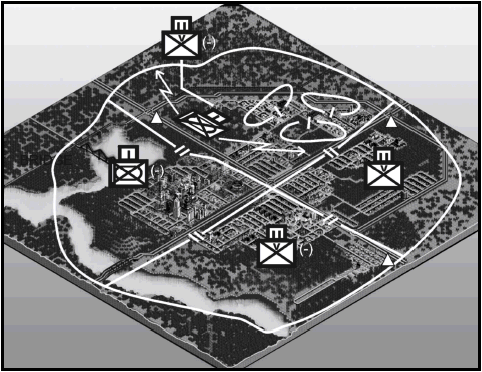
Figure J-18. Nodal defense, varying defensive techniques.
J-23. DEFENSIVE PLANNING
In planning a defense in an urban area, the staff must identify the following:
- Positions and areas that must be controlled to prevent enemy infiltration.
- Sufficient covered and concealed routes for movement and repositioning of forces.
- Structures and areas that dominate the urban area.
- Areas such as parks and broad streets that provide fields of fire for tanks and antiarmor weapons.
- Position areas for artillery assets.
- C2 locations.
- Protected areas for CSS activities.
- Suitable structures that are defensible and provide protection for defenders.
- Contingency plans in the event that the brigade must conduct breakout operations.
- Plans for rapid reinforcement.
a. Units defending in urban areas must prepare their positions for all around defense. Units must employ aggressive security operations that include surveillance of surface and subsurface approaches. Units must constantly patrol and use OPs and sensors to maintain effective security. Special measures must be taken to control possible civilian personnel who support the enemy or enemy combatants who have intermixed with the local population. Consideration must also be given to the protection of non-combatants that remain in the AO, and contingency actions in the event that the situation deteriorates and requires their evacuation.
b. Defensive fire support in urban operations must take advantage of the impact of indirect fires on the enemy before he enters the protection of the urban area. Fire support officers at all levels must coordinate and rehearse contingencies that are inherent to nonlinear fire support coordination measures and clearance of fires. Mutually supporting observation plans for daylight and periods of limited visibility must account for the degradation of lasers in well-lit urban areas. The fire support officer also plans and coordinates nonlethal capabilities for the brigade. Civil affairs and PSYOP assets should be coordinated with the appropriate command and control warfare/information operations headquarters.
Section VI. STABILITY AND SUPPORT OPERATIONS
The brigade's primary purpose is to fight and win engagements. However, brigades are versatile and have the flexibility to transition into military operations other than war (MOOTW). They can operate in environments that may not involve traditional combat. The brigade will conduct MOOTW through the execution of stability and support operations. A brigade may be called upon to conduct a stability or support contingency operation and then have to quickly transition into offensive or defensive operations. The brigade may also be utilized in a stability or support operation at the successful conclusion of a combat operation. When assigned a stability or support mission, a well-trained brigade must be able to rapidly shift its focus from war fighting to stability and support and also from stability and support to war fighting. During a stability or support operation, the brigade performs numerous activities. Essentially, the brigade accomplishes these activities through execution of tactical missions. While stability and support operations can occur anywhere, they will most likely occur in an urban environment. (See Appendix H and FM 7-98 for additional planning considerations.)
J-24. STABILITY OPERATIONS
Stability operations encompass a range of actions that shape the strategic environment and respond to developing crises. The purposes of stability operations are to―
- Protect national interests.
- Promote peace or deter aggression.
- Satisfy treaty obligations or enforce agreements and policies.
- Reassure allies, friendly governments, and agencies.
- Encourage a weak or faltering government.
- Maintain or restore order.
- Protect life and property.
- Demonstrate resolve.
- Deter or respond to terrorism.
- Reduce the threat of conventional arms and WMD to regional security.
- Eliminate or contain subversion, lawlessness, and insurgency.
a. Considerations for Stability Operations. Conducting stability operations is fundamentally identical to conducting combat operations. While each stability operation is different, the military decision-making process (MDMP) and troop-leading procedures methodologies apply. The considerations listed below supplement those processes and can help the brigade commander and staff in developing tailored concepts and schemes for stability operations.
- Leverage interagency, joint, and multinational cooperation.
- Enhance the capabilities and legitimacy of the host nation.
- Understand the potential for unintended consequences of individual and small unit actions.
- Display the capability to use force without threatening the population.
- Act decisively to prevent escalation.
- Apply force selectively and discriminately.
- Stress force protection.
- Emphasize information operations.
b. Types of Stability Operations. Table J-7 depicts the types of stability operations a brigade may be called upon to conduct, and the missions it will issue its subordinate battalions or TFs in order to execute its stability operation(s).
|
TYPE |
MISSIONS |
|
Peace Operations |
Peacekeeping: employ patrols, establish checkpoints, roadblocks, buffer zones, supervise truce, EPW exchange, reporting and monitoring, negotiation and mediation, liaison, investigation of complaints and violations, civil disturbance missions, and offensive and defensive missions. Peace Enforcement: separate belligerents; establish and supervise protected zones, sanction enforcement, movement denial and guarantee, restoration and maintenance of order, area security, humanitarian assistance, civil disturbance missions, and offensive and defensive missions. Operations in Support of Diplomatic Efforts: conduct military-to-military contacts, conduct exercises, provide security assistance, restore civil authority, rebuild physical infrastructure, provide structures and training for schools and hospitals, and reestablish commerce. |
|
Foreign Internal Defense |
Indirect Support: military-to-military contacts, exercises, area security. Direct Support: civil-military operations, intelligence and communications sharing, and logistical support. Combat Operations: offensive and defensive missions. |
|
Support to Insurgencies |
Show of force, defensive missions, raids, area security, employ patrols, and provide CSS. |
|
Counterdrug Operations |
Liaison and advisor duty, civic action, intelligence support, surveillance support, reconnaissance, logistical support, and information support. |
|
Combating Terrorism |
Conduct force protection, offensive and defensive missions. |
|
Noncombatant Evacuation Operations |
Attack to seize terrain that secures evacuees or departure area, guard, convoy security, delay, and defend. (See FM 90-29.) |
|
Arms Control |
Seize and destroy weapons, convoy escort, assist and monitor inspection of arms, and conduct surveillance. |
|
Show of Force |
Perform tactical movement, demonstration, defensive operations, and perform training exercises. |
|
Domestic Civil Disturbance Operations |
Assist law enforcement activities and security operations. |
Table J-7. Types of stability operations, missions.
J-25. SUPPORT OPERATIONS
Support operations provide essential supplies and services to assist designated groups. They are conducted to help foreign and civil authorities respond to crises. Brigades conduct support operations to save or protect lives, reduce suffering, recover essential infrastructure, improve the quality of life, and restore situations to normal. Again, planning for support operations is fundamentally identical to planning for combat and stability operations. While each support operation is different, the military decision-making process and troop-leading procedures methodologies apply. Considerations that can assist the brigade commander and staff in developing plans for support operations are:
- Provide essential support to the largest number of people.
- Coordinate actions with other agencies.
- Establish measures of effectiveness.
- Hand over to civilian agencies as soon as feasible.
- Conduct robust information operations.
- Secure the force.
a. Types of Support Operations. The two types of support operations that brigades will conduct are domestic support operations (DSO) and foreign humanitarian assistance (FHA). Brigades conduct DSO in the US and its territories and FHA outside the US and its territories. Brigades normally conduct stand-alone FHA operations only in a permissive environment. In uncertain and hostile environments, brigades conduct FHA operations as part of larger stability or offensive and defensive operations.
b. Forms of Support Operations. During DSO brigades perform relief operations, provide support to incidents involving WMD, provide support to law enforcement, and perform community assistance. In FHA brigades most often conduct relief operations; however, FHA may also involve support to incidents involving WMD and community assistance. Missions and tasks assigned to subordinate battalions or TFs often overlap during the conduct of support operations. Table J-8 depicts the more common missions that will be assigned to subordinate battalions or TFs.
|
FORMS OF SUPPORT OPERATIONS |
MISSIONS |
|
Relief Operations |
Search and rescue, food & water distribution, providing temporary shelter, transportation support, medical support, sanitation, area security. |
|
Support to Incidents Involving WMD |
Assisting law enforcement, area security, protection of critical assets (utilities, transportation, banking, telecommunications), responding to WMD casualties, establishing roadblocks/checkpoints. |
|
Support to Civil Law Enforcement |
Civil disturbance missions; support to counterterrorism and counterdrug operations; providing resources, training, and augmentation; assisting with cordon and search; security patrols; establish roadblocks and checkpoints. |
|
Community Assistance |
Search and rescue, firefighting, assistance in safety and traffic control, emergency snow removal, providing temporary shelter. |
Table J-8. Forms of support operations, missions.
c. Other Agencies. Because of the nature support operations, the brigade can expect additional strains on its logistical system and other assets such as engineers, medical, and MPs. Support operations rely on a partnership with other government and non-government organizations. Liaison with these agencies and between local governments is critical. Regardless of the positive relationships built, force protection always remains a top priority.
J-26. TRANSITION TO COMBAT OPERATIONS
Stability, and to a lesser extent, support operations are missions that may transition to combat. The commander and staff must always keep in mind that the pendulum can also shift from a stability or support operation to combat. An escalation to combat is a clear indicator that the stability or support operation failed. The brigade must always retain the ability to conduct offensive and defensive operations. Preserving the ability to transition allows the brigade to maintain initiative while providing force protection.
a. Perception of Power. The knowledge that the brigade is a viable presence because of its combat power must be coupled with the perception that it will employ its power if necessary. This perception is the primary means by which the brigade deters escalation to hostile action. The commander must plan for contingency operations that factor in what actions the brigade will perform if combat cannot be averted. In addition, how the brigade is task organized and how the AO is designed must support an expeditious transition.
b. Balanced Mindset. Soldiers must be able to properly adjust and balance the mindset of peace operations with the mindset of war fighting. Soldiers cannot become too complacent in their warrior spirit, but also must not be too eager to rely on the use of force to resolve conflict. This balance is the essence of peace operations and the fundamental aspect that will enable the brigade to perform its mission successfully and avoid an escalation to combat.
c. Combat Skills Training. If the stability or support operation extends over prolonged periods of time, training should be planned that focuses on the individual and collective combat tasks that would be performed during transition to offensive and or defensive missions.
|
NEWSLETTER
|
| Join the GlobalSecurity.org mailing list |
|
|
|

